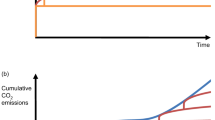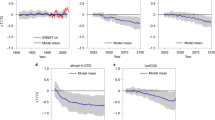Abstract
Recent studies have suggested that global mean surface temperature would remain approximately constant on multi-century timescales after CO2 emissions1,2,3,4,5,6,7,8,9 are stopped. Here we use Earth system model simulations of such a stoppage to demonstrate that in some models, surface temperature may actually increase on multi-century timescales after an initial century-long decrease. This occurs in spite of a decline in radiative forcing that exceeds the decline in ocean heat uptake—a circumstance that would otherwise be expected to lead to a decline in global temperature. The reason is that the warming effect of decreasing ocean heat uptake together with feedback effects arising in response to the geographic structure of ocean heat uptake10,11,12 overcompensates the cooling effect of decreasing atmospheric CO2 on multi-century timescales. Our study also reveals that equilibrium climate sensitivity estimates based on a widely used method of regressing the Earth’s energy imbalance against surface temperature change13,14 are biased. Uncertainty in the magnitude of the feedback effects associated with the magnitude and geographic distribution of ocean heat uptake therefore contributes substantially to the uncertainty in allowable carbon emissions for a given multi-century warming target.
This is a preview of subscription content, access via your institution
Access options
Subscribe to this journal
Receive 12 print issues and online access
$209.00 per year
only $17.42 per issue
Buy this article
- Purchase on Springer Link
- Instant access to full article PDF
Prices may be subject to local taxes which are calculated during checkout


Similar content being viewed by others
References
Allen, M. R. et al. Warming caused by cumulative carbon emissions towards the trillionth tonne. Nature 458, 1163–1166 (2009).
Matthews, H. D. & Caldeira, K. Stabilizing climate requires near-zero emissions. Geophys. Res. Lett. 35, L04705 (2008).
Plattner, G-K. et al. Long-term climate commitments projected with climate–carbon cycle models. J. Clim. 21, 2721–2751 (2008).
Eby, M. et al. Lifetime of anthropogenic climate change: Millennial time-scales of potential CO2 and surface temperature perturbations. J. Clim. 22, 2501–2511 (2009).
Frölicher, T. L. & Joos, F. Reversible and irreversible impacts of greenhouse gas emissions in multi-century projections with the NCAR global coupled carbon cycle-climate model. Clim. Dynam. 35, 1439–1459 (2010).
Matthews, H. D., Gillet, N., Scott, P. A. & Zickfeld, K. The proportionality of global warming to cumulative carbon emissions. Nature 459, 829–832 (2009).
Solomon, S., Plattner, G-K., Knutti, R. & Friedlingstein, P. Irreversible climate change due to carbon dioxide emissions. Proc. Natl Acad. Sci. USA 106, 1704–1709 (2009).
Zickfeld, K., Eby, M., Matthews, H. D. & Weaver, A. J. Setting cumulative emissions targets to reduce the risk of dangerous climate change. Proc. Natl Acad. Sci. USA 106, 16129–16134 (2009).
Gillet, N. P., Arora, V. K., Zickfeld, K., Marshal, S. J. & Merryfield, W. J. Ongoing climate change following a complete cessation of carbon dioxide emissions. Nature Geosci. 4, 83–87 (2011).
Winton, M., Takahashi, K. & Held, I. M. Importance of ocean heat uptake efficacy to transient climate change. J. Clim. 23, 2333–2344 (2010).
Armour, K. C., Bitz, C. M. & Roe, G. H. Time-varying climate sensitivity from regional feedbacks. J. Clim. 26, 4518–4534 (2013).
Geoffroy, O. et al. Transient climate response in a two-layer energy-balance model. Part II: Representation of the efficacy of deep-ocean heat uptake and validation for CMIP5 AOGCMs. J. Clim. 26, 1859–1879 (2013).
Gregory, J. M. et al. A new method for diagnosing radiative forcing and climate sensitivity. Geophys. Res. Lett. 31, L03205 (2004).
Andrews, T., Gregory, J. M., Webb, M. J. & Taylor, K. E. Forcing, feedbacks and climate sensitivity in CMIP5 coupled atmosphere-ocean climate models. Geophys. Res. Lett. 39, L09712 (2012).
Dunne, J. P. et al. GFDL’s ESM2 global coupled climate-carbon Earth system models. Part I: Physical formulation and baseline simulation characteristics. J. Clim. 25, 6646–6665 (2012).
Dunne, J. P. et al. GFDL’s ESM2 global coupled climate-carbon Earth system models. Part II: Carbon system formulation and baseline simulation characteristics. J. Clim. 26, 2247–2267 (2013).
Doney, S. C., Lindsay, K., Fung, I. & John, J. Natural variability in a stable 1000-yr global coupled climate-carbon cycle simulation. J. Clim. 19, 3033–3054 (2006).
Frölicher, T. L., Joos, F., Plattner, G-K., Steinacher, M. & Doney, S. C. Natural variability and anthropogenic trends in oceanic oxygen in a coupled carbon cycle-climate model ensemble. Glob. Biogeochem. Cycle 23, GB1003 (2009).
Hansen, J. et al. Efficacy of climate forcings. J. Geophys. Res. 110, D18104 (2005).
Zelinka, M. D. & Hartmann, D. L. Climate feedbacks and their implications for poleward energy flux changes in a warming climate. J. Clim. 25, 608–624 (2012).
Winton, M., Griffies, S. M., Samuels, B. L., Sarmiento, J. L. & Frölicher, T. L. Connecting changing ocean circulation with changing climate. J. Clim. 26, 2268–2278 (2013).
Li, C., von Storch, J-S. & Marotzke, J. Deep-ocean heat uptake and equilibrium climate response. Clim. Dynam. 40, 1017–1086 (2013).
Delworth, T. L. et al. GFDL’s CM2 global coupled climate models. Part I: Formulation and simulation characteristics. J. Clim. 19, 643–674 (2006).
Meehl, G. A. et al. Response of the NCAR climate system model to increased CO2 and the role of physical processes. J. Clim. 13, 1879–1898 (2000).
Otto, A. et al. Energy budget constraints on climate response. Nature Geosci. 6, 415–416 (2013).
Matthews, H. D., Solomon, S. & Pierrehumbert, R. Cumulative carbon as a policy framework for achieving climate stabilization. Phil. Trans. R. Soc. A 370, 4365–4379 (2012).
Boden, T., Marland, G. & Andres, R. J. Global, Regional, and National Fossil-Fuel CO 2 Emissions (Carbon Dioxide Information Analysis Center, Oak Ridge National Laboratory, US Department of Energy, 2011); http://dx.doi.org/10.3334/CDIAC/00001_V2010
Houghton, R. A. et al. Carbon emissions from land use and land-cover change. Biogeosciences 9, 5125–5142 (2012).
Ramaswamy, V. et al. in IPCC Climate Change 2001: The Scientific Basis (ed. Houghton, H. T.) 349–416 (Cambridge Univ. Press, 2001).
Acknowledgements
We thank D. Paynter, T. Merlis, K. Rodgers, J. Dunne and N. Gruber for useful discussions and comments. We also thank B. L. Samuels for conducting the GFDL ESM2M simulations and R. Roth for help with the impulse response function calculations. Simulations with the NCAR CSM1 were carried out at the University of Bern, Switzerland. T.L.F. acknowledges financial support from the SNSF (Ambizione grant PZ00P2_142573). J.L.S. was supported by the Carbon Mitigation Initiative (CMI) project at Princeton University, sponsored by BP.
Author information
Authors and Affiliations
Contributions
T.L.F. and M.W. designed the study and undertook main analysis. T.L.F. performed simulations and wrote the paper, with significant text supplied by all authors, who also discussed the results.
Corresponding author
Ethics declarations
Competing interests
The authors declare no competing financial interests.
Supplementary information
Rights and permissions
About this article
Cite this article
Frölicher, T., Winton, M. & Sarmiento, J. Continued global warming after CO2 emissions stoppage. Nature Clim Change 4, 40–44 (2014). https://doi.org/10.1038/nclimate2060
Received:
Accepted:
Published:
Issue Date:
DOI: https://doi.org/10.1038/nclimate2060
This article is cited by
-
Emergent climate change patterns originating from deep ocean warming in climate mitigation scenarios
Nature Climate Change (2024)
-
Global disruption of coral broadcast spawning associated with artificial light at night
Nature Communications (2023)
-
Estimating the timing of geophysical commitment to 1.5 and 2.0 °C of global warming
Nature Climate Change (2022)
-
Past and future ocean warming
Nature Reviews Earth & Environment (2022)
-
Response relationships between abrupt seasonal temperature changes/warming (cooling) hiatuses in China and their influencing factors
Environmental Science and Pollution Research (2021)



